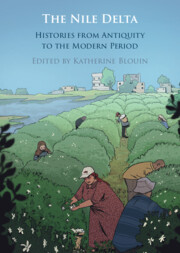Book contents
- The Nile Delta
- The Nile Delta
- Copyright page
- For Mona Abaza
- Contents
- Figures
- Maps
- Tables
- Contributors
- Acknowledgements
- Abbreviations
- 1 Introduction
- 2 Call Me by My Names
- 3 The Nile Delta before the Pharaohs
- 4 The Khetem-Border-Posts in the Delta during the New Kingdom
- 5 New Land amongst New Rivers?
- 6 The Mareotis Area
- 7 From Memphis to Alexandria
- 8 Growing with the Empire? From Village to Town
- 9 Mapping the Cult of Christian Saints in the Nile Delta from the Fifth to the Ninth Century CE
- 10 Alexandria
- 11 Imperial Power, Tribal Settlement and Fiscal Revolts in the Early Islamic Delta (Seventh to Ninth Century CE)
- 12 The Nile as Nexus
- 13 Water and Prices
- 14 Water Development in the Medieval Western Delta
- 15 The Nile Delta in European Cartography, 1200–1800
- 16 Just Passing Through?
- 17 Reclaiming the Archive
- 18 Short Commentary on Accounting Documents from a Vanishing Cotton Estate (ʿIzba) in the Nile Delta
- Index
- References
11 - Imperial Power, Tribal Settlement and Fiscal Revolts in the Early Islamic Delta (Seventh to Ninth Century CE)
Published online by Cambridge University Press: 15 February 2024
- The Nile Delta
- The Nile Delta
- Copyright page
- For Mona Abaza
- Contents
- Figures
- Maps
- Tables
- Contributors
- Acknowledgements
- Abbreviations
- 1 Introduction
- 2 Call Me by My Names
- 3 The Nile Delta before the Pharaohs
- 4 The Khetem-Border-Posts in the Delta during the New Kingdom
- 5 New Land amongst New Rivers?
- 6 The Mareotis Area
- 7 From Memphis to Alexandria
- 8 Growing with the Empire? From Village to Town
- 9 Mapping the Cult of Christian Saints in the Nile Delta from the Fifth to the Ninth Century CE
- 10 Alexandria
- 11 Imperial Power, Tribal Settlement and Fiscal Revolts in the Early Islamic Delta (Seventh to Ninth Century CE)
- 12 The Nile as Nexus
- 13 Water and Prices
- 14 Water Development in the Medieval Western Delta
- 15 The Nile Delta in European Cartography, 1200–1800
- 16 Just Passing Through?
- 17 Reclaiming the Archive
- 18 Short Commentary on Accounting Documents from a Vanishing Cotton Estate (ʿIzba) in the Nile Delta
- Index
- References
Summary
The history of Egypt during the first centuries of Islam comes with a striking paradox. While Upper Egypt, from Fusṭāṭ to Aswan, has received much attention due to the numerous papyri from the region, the Delta is rarely attested in these documents. This is most probably linked to the region’s humid soil, which contributed to the progressive degradation of papyri. Indeed, other than a few private letters written in Alexandria, no papyri from this period have been found in the Delta. Despite this, the Delta occupied a central place in the imperial construction of Islam, especially during the Umayyad period (40/661–132/750): it linked the new capital, Fusṭāṭ, to the Mediterranean and its main cities, was the prime locus of Arab settlement from the second/eighth centuries and was a choice transit space to Syria-Palestine and Cyrenaica. Based on narratives by Egyptian Muslim writers and papyrological documents mentioning the Delta, we can sketch the history of the administrative and fiscal management of this space, to follow the process of tribal settlement in relationship with imperial policies and to analyse the latter’s consequences on the social situation in the Delta at the end of the Umayyad period and in the early Abbasid period.
- Type
- Chapter
- Information
- The Nile DeltaHistories from Antiquity to the Modern Period, pp. 397 - 420Publisher: Cambridge University PressPrint publication year: 2024



